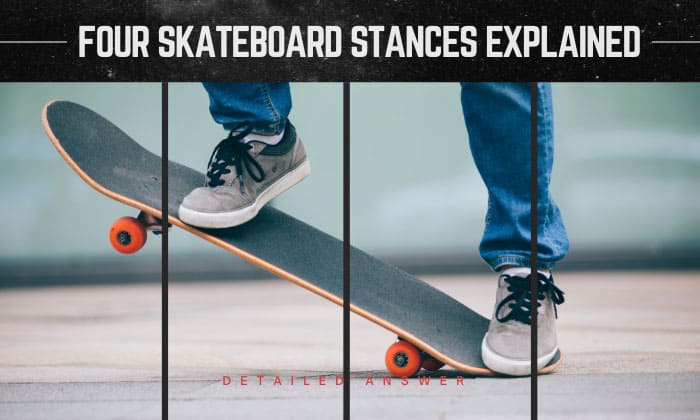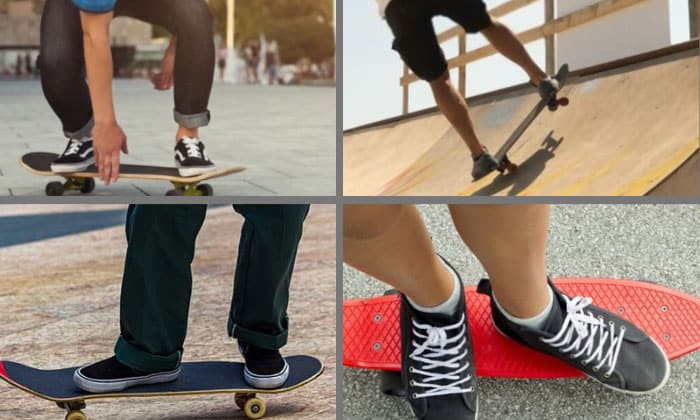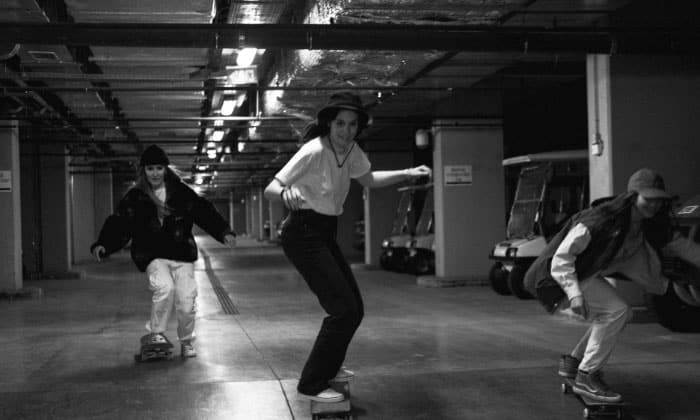The best preparations yield the best results, whether in sports or other things. Let’s take skateboarding, for example. What makes professional skaters ace tricks and stunts? Practice and preparation.
These preparation routines include the skater’s stance, pushing, jumping, and more.
Regarding the stance in particular, did you know that this fundamental skill actually varies? If not, let’s have the four skateboard stances explained.
In this article, we will help you understand what the nollie, natural, switch, and fakie are and how they’ll affect your performance.
Table of Contents
The Four Skateboard Stances
What does stance mean in skateboarding? As mentioned, our stance determines how we stand and the outcome of our skateboard routine. It’s the first thing we master when doing the sport.
Let’s discuss different skateboard positions.
1. The natural stance
Of the four, the natural stance is the most variable. Why? Because it can be either a regular or goofy skateboard foot position.
What is a regular natural stance? Regular-footed skateboard riders place their left foot closer to the deck’s nose while their right foot is on the tail.
How about goofy? Like a skateboard stance mongo, some skaters find this style unusual. Goofy-footed skateboarders put their right foot forward, leaving the left foot behind.
But how will skaters know they’re regular or goofy?
This aspect is one of the challenges for new and average skateboarders. Nonetheless, there is one guaranteed test to find the answer, and it’s simple. Have someone stand behind you and let that person push you from the back.
The first foot you set forward to support your body is your front. Hence, that’s the one you’re going to place closer to the front truck bolt.
All in all, the natural stance considers both regular and goofy as acceptable. So, don’t feel bothered if you place one foot forward differently than others.
2. The fakie
The fakie stance is the natural stance. The only difference rests on where the skateboard moves. To be clear, it’s like doing the regular skateboard stance, but your board rolls in your rear foot’s direction or backwards.
In what instances does a fakie occur? Take note of the following.
- You’re riding on an upward-sloping trail, and the skateboard rolls back.
- You switch your back foot to the front by rotating the skateboard.
- You perform Big Spins and 180s.
3. The nollie stance
If you look at the nollie stance, it looks a bit like the natural stance. However, your front foot will be on the nose instead of just close to it. Your back foot will move forward slightly as well.
It might look awkward, but you’ll still be stable once you master it.
4. The switch stance
Perhaps, the switch is the most challenging of the four skateboarding stances, especially for beginners.
The switch makes the skater place his feet on the board in unorthodox positions. That means regular-footed riders will find their left foot on the tail.
In contrast, goofy-footed skaters will switch to regular.
Making this shift in your stance in skateboarding might not only be uncomfortable. It could also mean safety issues in your execution of tricks and other skills. Still, practice will make the switch stance possible.
Goofy Vs Regular Skateboard Stance: What is the Difference?
We talked about how the skater’s natural position varies and becomes apparent after a push from his back. Either way, every skater is regular or goofy-footed. Let’s dig more into their differences, beginning with the goofy skateboard stance.
Skaters who ride their boards with their right foot forward are more efficient in performing challenging tricks. Why? This is because this type of rider finds better stability, thanks to easier forward leaning and a lower center of gravity brought by being goofy-footed.
There is also a theory that goofy-footed skateboarding makes riders more fluid in movements. But that argument still needs proof.
On the other hand, regular-footed skateboarding is more for relaxing rides. While this stance enables skaters to perform tricks, it limits them to the less challenging sets.
Nonetheless, being regular-footed means smooth cruising for the skater.
Related: How to Find Your Skateboarding Stance: Goofy or Regular
Frequently Asked Questions
What are the things to consider before learning skateboard stances?
It’s easy to want to become the skaters riding different skateboard styles in the parks. But remember, you might not have the same preference as theirs. Aside from the skateboard stance names, there are things you should remember before finding your ideal footing.
- Comfort – Never push yourself to do something too unnatural to what you are familiar with.
- Efficiency – You should decide what stance will help you learn better and more quickly.
- Confidence – Goofy and regular positions are valid. Care not about what people say.
- Consistency – Before picking your go-to skateboard stance, ensure you will commit to applying it.
Why is it called goofy stance?
Of hundreds of skateboard riding styles, you wouldn’t think it’s the fictional character you loved as a kid that gave rise to the Goofy moniker.
However, that is where this stance got its name. But why?
This fun cartoon character got portrayed riding his skateboard right foot forward. And since then, it has become the label every skater applies. Not only do skateboarders use such a term, but wakeboard, snowboard, and surfboard users do so as well.
Conclusion
When skateboarding, our goal is to make every move precise. This way, we prevent accidents and learn the most impressive tricks. And like any sport, skateboarding begins with the fundamentals, like the stance.
So, now that we have the four skateboard stances explained, working your way to more advanced and complicated skateboarding skills will be more manageable.
Remember, settle where you are most comfortable. Be confident and driven, and find consistency. Eventually, improvement will follow.

Hi, I am Charles Harris. I opened this site to write as much as I can about my biggest passion – skateboarding!
I started as a clumsy yet passionate rookie 10 years ago to now a still passionate yet much better skateboarder! But I have to tell you, the whole journey has always been fun and rewarding, indeed not without hardship.




